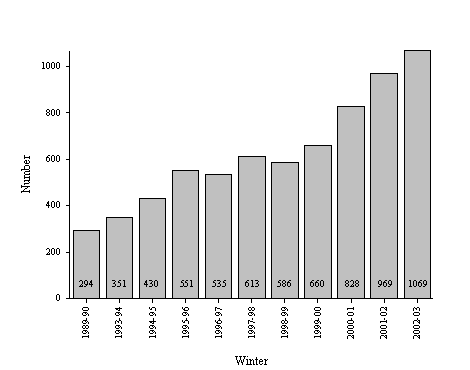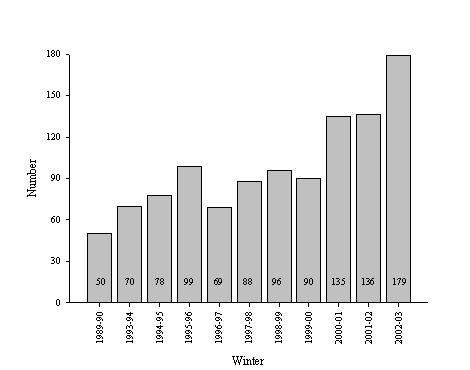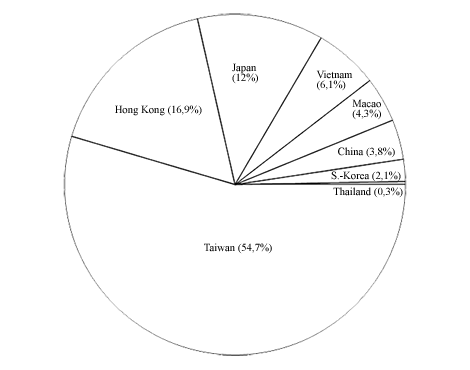Introduction
The Black-faced Spoonbill Platalea minor is a globally endangered species (BirdLife International 2000), only distributed along the east fringe of Asia. Its known world population has been put at less than 1000 individuals (Dahmer and Felley Unpub. MS 2002). Known wintering populations of the Black-faced Spoonbill have been assessed by international census since 1993 (organised by Tom Dahmer) and this census was classified as "high priority" byseveral recommendations listed in the 'Action Plan for the Black-faced Spoonbill Platalea minor' (Severinghaus et al. 1995). At the International Black-faced Spoonbill Workshop held in Beijing in 1996 (hosted by the Wild Bird Society of Japan), representatives from all range countries agreed to support Mr. Dahmer's census to gain a wider coverage of wintering grounds.
This census is proven to be an effective and practical means to provide information of the known populations and to indicate distribution of wintering Black-faced Spoonbills. Mr. Dahmer decided to hand over the voluntary coordination to Hong Kong Bird Watching Society (HKBWS) (The BirdLife International affiliate) in 2002. HKBWS accepted the responsibility to start international coordination of the International Census from 2003. This mid-winter census was undertaken in wintering sites from 24-26 January.
Material and methods
Dates of censuses were fixed on 24, 25 and 26 January 2003. Census dates have been usually chosen in mid or late January because the spoonbills seem to be stable in the mid-winter. Counting of the spoonbills rely on voluntary efforts from counters including experienced bird watchers, researchers and ornithologists. The censuses in Hong Kong, Macau, Taiwan, Vietnam and Japan are summarized by national coordinators. In the last few years Taiwanese birdwatchers had assisted the census in Vietnam. The Censuses in South Korea, Mainland China and Thailand are not yet done in a coordinated manner and reports are submitted from different individuals. The counts covered nine countries or regions (Map 1) in a synchronized manner. Surveys were carried out in areas where Black-faced Spoonbills have been reported. Field counts were made using binoculars and telescopes.
Some sites are located within a single larger area: for example, Mai Po in Hong Kong, Futian in Shenzhen, and Taipa in Macau are all in the Pearl River Delta of South China. Spoonbills can fly between these sites on the same day, so censuses in these sites were co-ordinated and conducted at the same time.
Counters recorded numbers of Black-faced Spoonbills, and noted location and time of counts at sites. In the previous counts observers were asked to send in number of immature birds as well, but this may not be easy for sites with many spoonbills (e.g. Taiwan and Hong Kong) or sites without experienced observers and good field scopes (e.g. Mainland China). Information was then reported to the International Coordinator, Hong Kong Bird Watching Society.
Results and discussion
Overview: A minimum of 1069 Black-faced Spoonbills were counted in the census this year (Table 1), the first time spoonbill numbers have exceed 1000 individuals. The actual number of spoonbills may be higher than this number as we have received a record of twelve spoonbills also present in Hainan Island (Table 2). However, these counts were not made during the period of the International Census and hence this number is not included in this census. An outbreak of botulism in Tsengwen estuary, Taiwan killed a total of 73 Black-faced Spoonbills in late 2002/early 2003: had this not occurred the total number would have exceeded 1100.
The census shows that he known world population of Black-faced Spoonbill has increased for five consecutive years since 1998. There is also a minimum 10% increase compared with the census result of 2002. In addition, numbers of the spoonbills has increased generally since the commencement of the international census (Figure 1).
Hong Kong and Pearl River Delta
In Hong Kong, numbers of Black-faced Spoonbill have increased since 1980s. Annual peak numbers of the spoonbills increased from 50 individuals in 1989 (Kennerley 1990) to 258 on 31 December 2002 (P.J. Leader pers. comm.). However, the censuses result in the past shows numbers of spoonbill in Hong Kong relatively smaller and stable till 2000 and the numbers only reached to 99 in winter 1995-96. Then numbers has then increased to 136 and 137 individuals in January 2001 and 2002 respectively because of the improved census effort and almost certainly a real increase of the wintering population. The census in Hong Kong was undertaken on a large scale in January 2003, covering the whole Deep Bay area including Mai Po Nature Reserve, Lok Ma Chau, Tsim Bei Tsui (Inner Deep Bay), and Lau Fau Shan to Nim Wan (Outer Deep Bay). As a result, the highest census count so far - 179 birds - was recorded (Figure 2). Counting in Futian and Macao during the census found another 24 and 46 birds respectively. These were added with the Mai Po counts to give a total of 249 birds in the Pearl River delta.
The total number is comparable to that of the peak number (i.e. 258 birds) in winter 2002-03. It indicates that birds in Macao and Futian might belong to the same wintering group in the Mai Po Deep Bay Ramsar site. A sighting of colour-ringed Black-faced Spoonbills in Futian (e.g. Anon 2001) supports this speculation. However, movement of Black-faced Spoonbills between Macao and Hong Kong is still needed to be proved.
Main Wintering Sites
Percentages of known numbers of Black-faced Spoonbills for each country and region were shown in Figure 3. It shows that Tsengwen estuary and area nearby Tainan is the largest wintering site and a total of 562 (52.6%) individuals were recorded, while Mai Po and Deep Bay area is the second largest where 179 (16.7%) birds were counted. Xuan Thuy in the Red River Delta of Vietnam also holds 65 (6.1%) spoonbills, which is the third largest site. In this census, a total of 75.4% of the known wintering population of the spoonbills was recorded in these three sites. In addition, spoonbill numbers in Tsengwen Estuary area have been increasing drastically since 1996-97, while numbers in Mai Po only rise steadily. In Red River Delta, numbers have been decreased since 1995-96 and become stable in recent years (Figure 4).
The survey in Japan is coordinated by the Japan Black-faced Spoonbill Network formed in June 2002 and the Wild Bird society of Japan. Since 2000 the total number recorded in Japan has been rather stable (slightly less than 100 birds). This year the number increased to 128 birds. That was probably a real increase in number of birds wintering in Japan.
Surveys in Southeast China
The southeast China coast was largely under-surveyed in the past due to its extensive area, lack of observers and baseline information, and difficulties in communication. In this census, volunteers in China were invited to carry out the census in sites along the coast including Chongming Dao of Shanghai Municipality, Quanzhou of Fujian Province, Panyu, Leizhou Peninsular and Zhanjiang area of Guangdong Province. However, survey in Quanzhou was finally cancelled because vehicle was broken and counter could not access the area. Surveys in Leizhou Peninsula and Zhanjiang were only managed to be carried out before the period of census, but no spoonbills were found.
Threats
Wintering Black-faced Spoonbills are largely concentrated in three sites, which raised the threat that the spoonbill is susceptible to a catastrophic event and to habitat deterioration and other threats might that might reduce their number in a large extent.
One notable example is the recent mass death of seventy three Black-faced Spoonbills caused by Avian Botulism. The higher the congregation in one site, the higher the extent of threats the population would face. It indicates this species is still facing high risk of extinction.
Acknowledgements
This census could be undertaken without support from enthusiastic counters for data collection. Thanks to all following counters: Nik Aspey, H.F. Cheung, Louis Cheung, Paul Collins, Forrest Fong, Ho Man-fai, Tobi Lau, Li Wai-ki, Paul Leader, Judy Wan, Dickson Wong, Agriculture, Fisheries and Conservation Department (Hong Kong); Jang Kejia, Jiang Hangdong, Kang Hongli Liang Wei, Lu Ni, Wang Hui, Wang Jieyi, Wang Xiwen, Wang Yongjun, Yu Haiyan, Zhang Guogang, Zhou Fasang (China); Leung Va (Macao) Fang Woei-horng, Chen Chieh-peng, Chen Chung-tao, Chen Shang-chin, Chou Chung-yi, Ho Jen-te, Hu Lin-chih, Huang Nan-ming, Hung Sheng-yu, Li Yu-jen, Pan Chih-yuan, Wang Hsin-hua, Wu Hsin-ho, Wild Bird Federation of Taiwan (Taiwan), Nguyen Duc Tu, Le Trong Trai, Jack Tordoff, BirdLife International Indochina Programme (Vietnam); Marlynn Mendoza (The Philippines); Choi Chang-yong, Kim Wan-byung (South Korea), Shiori Asai, Simba Chan, Kinuko Hakoda, Takami Hakoda, Takuro Hattori, Masataka Hanada, Osamu Hayashi, Tamiko Higuchi, Tetsuya Higuchi, Hiroshi Hikita, Kyoichiro Imamura, Fumitaka Iseki, Ryuta Kano, Yasuko Kano, Nobuko Kawakami, Kaori Kitada, Kimiko Kouno, Takanari Kubo, Hiroshi Kukita, Yukinori Kurihara, Satoru Matsumoto, Yoshifumi Matsumoto, Reiko Matsuoka, Kazumasa Matsushima, Nagashisa Mita, Keiko Miyano, Yasuo Miyazaki, Toshio Naka, Akira Sakai, Kenichi Siraishi, Sanehiko Sonoda, Shigeki Takano, Shigeki Takano, Naoko Takayama, Yoshimichi Tsuchiya, more than 100 citizens of Tsuyazaki Town, Mutsuyuki Ueta, Kunihiko Watanabe, Hiroshi Yamaguchi, Mr. Yamane, Wild Bird Society of Japan (Japan).
References
- BirdLife International. 2000. Threatened Birds of the World. Lynx Edicions and BirdLife International, Barcelona and Cambridge, UK.
- Dahmer, T. and Felley, M. 2002. Summary of 2002 Winter Census of Black-faced Spoonbill Platalea minor. Ecosystem Ltd. Unpub. MS.
- Kennerley, P.R. 1990. A review of the status and distribution of the Black-faced Spoonbill. Hong Kong Bird Report 1989: 83-100.
- Severinghaus, L.L., Brouwer, K., Chan, S. Chong, J.R., Coulter, M.C., Poorter, E.P.R. and Wang, Y. 1995. Action plan for the Black-faced Spoonbill Platalea minor. Published by the Chinese Wild Bird Federation, Taipei, Taiwan. "Task Force to Develop an Action lan for the Preservation of the Black-faced Spoonbill" Taipei, Taiwan. January 16-22, 1995.








